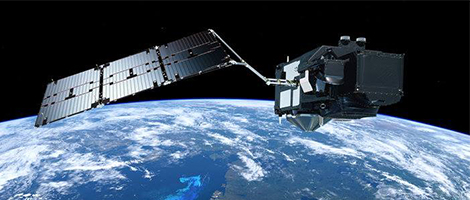
In November, the 22 member states of the
European Space Agency (ESA) granted the organization its largest funding to
date, including unprecedented €1.8 billion financing to expand the Copernicus program of Earth
monitoring satellites. This is particularly significant news for climate
activists and carbon dioxide (CO2) researchers, as the new money and soon-to-be
bigger fleet of Copernicus satellites called Sentinels will become the worlds'
leading CO2 space monitoring program — and the only one capable of
distinguishing between CO2’s human and natural sources.
Unprecedented
world coverage
The Sentinels are now scheduled to run for 20
years; lack of funding had blocked the launch since 2015, and the system was
renamed and redesigned to meet the Paris Agreement’s objectives and convince
ESA members to invest in the project. By 2025, three new Sentinels will be in
orbit, measuring CO2 concentration every three days at every location on the
planet, scanning the Earth in approximately 200 km wide swathes, and producing
images at 2x2 km resolution.
“The CO2 Monitoring Mission will have
unprecedented world coverage. This has never been done before,” says Dr. Richard
Engelen, deputy director of the Copernicus Atmosphere Monitoring Service.
A similarly ambitious program pioneered by NASA, the Orbiting Carbon Observatory (OCO), was launched in 2009 but underwent several financial knockdowns and technological failures. OCO-1 failed to reach the International Space Station where it was supposed to be stationed, and OCO-2 was designed to last only 2 years and could gather data from the same location with intervals that lasted weeks. OCO-3 met several budget cuts and was only restored in mid-2018. NASA scientists admit that they lost their chance to champion space CO2 monitoring, and now are following the lead of their European colleagues.
A new generation of satellite tech
Japan and China, two countries with space exploration ambitions, also have their own satellite monitors for CO2. The Chinese observation satellite TanSat was created in 2010 and launched in 2016. Designed to work for 3 years, TanSat will soon end its mission, but the government is already working on the new generation of satellites, using information gathered from space to manage high levels of air pollution.
Japan was the first country to design space CO2 monitors back in the 1990s, but its own space monitoring system was only launched in 2009. The Greenhouse Gases Observing Satellite (GOSAT) measures CO2 and methane densities at 56,000 different locations around the world, and last year a new generation of the satellite was sent to orbit. That same year, the Indian Space Research Organisation (ISRO) launched HySIS, a satellite monitoring pollution from industrial sources whose program is designed for five years.
Ever since 1996, when the first rocket with a CO2 monitor made in Japan left the Earth, satellite technology has developed at an impressive speed. By the time new EU Sentinels have taken off, our notions of how to save the planet and on how to destroy it will also have evolved.